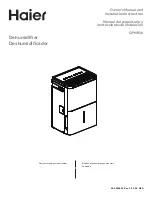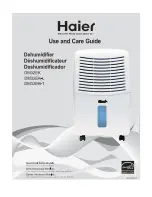
EN
3
dehumidifier TTK 175 S / TTK 355 S
Safety
Read this manual carefully before starting or using the
device. Always store the manual in the immediate vicinity
of the device or its site of use.
Warning
Read all safety warnings and all instructions.
Failure to follow the warnings and instructions may
result in electric shock, fire and/or serious injury.
Save all warnings and instructions for future
reference.
•
In the scope of European normative requirements
(EN 60335-1):
This appliance can be used by children aged from 8 years
and above and persons with reduced physical, sensory or
mental capabilities or lack of experience and knowledge if
they have been given supervision or instruction concerning
use of the appliance in a safe way and understand the
hazards involved. Children shall not play with the
appliance. Cleaning and user maintenance shall not be
made by children without supervision.
•
In the scope of International normative requirements
(IEC 60335-1):
This appliance is not intended for use by persons
(including children) with reduced physical sensory or
mental capabilities, or lack of experience and knowledge,
unless they have been given supervision or instruction
concerning use of the appliance by a person responsible
for their safety. Children should be supervised to ensure
that they do not play with the appliance.
•
Do not use the device in potentially explosive rooms or
areas and do not install it there.
•
Do not use the device in aggressive atmosphere.
•
Only put up the device in an upright, stable position on firm
ground.
•
Let the device dry out after a wet clean. Do not operate it
when wet.
•
Do not use the device with wet or damp hands.
•
Do not expose the device to directly squirting water.
•
Do not cover the device during operation.
•
Do not sit on the device.
•
This appliance is not a toy. Keep away from children and
animals.
•
Occasionally observe the device during operation.
•
Check accessories and connection parts for possible
damage prior to every use of the device. Do not use any
defective devices or device parts.
•
Ensure that all electric cables outside of the device are
protected from damage (e.g. caused by animals). Never
use the device if electric cables or the power connection
are damaged!
•
The mains connection must correspond to the
specifications in the Technical annex.
•
Insert the mains plug into a properly fused mains socket.
•
Observe the device's power input, cable length and
intended use when selecting extensions to the power
cable. Completely unroll extension cables. Avoid electrical
overload.
•
Do not under any circumstances use the device if you
detect damages on the mains plug or power cable.
If the power cable is damaged, it must be replaced by the
manufacturer, its service agent or similarly qualified
persons in order to avoid a hazard.
Defective power cables pose a serious health risk!
•
Before carrying out maintenance, care or repair work on
the device, remove the mains plug from the mains socket.
Hold onto the mains plug while doing so.
•
Switch the device off and disconnect the power cable from
the mains socket when the device is not in use.
•
When positioning the device, observe the minimum
distances from walls and other objects as well as the
storage and operating conditions specified in the Technical
annex.
•
Make sure that the air inlet and outlet are not obstructed.
•
Make sure that the suction side is kept free of dirt and
loose objects.
•
Never insert any objects or limbs into the device.
•
Do not remove any safety signs, stickers or labels from the
device. Keep all safety signs, stickers and labels in legible
condition.
•
Only transport the device in an upright position with an
emptied condensation tank or drain hose.
•
Discharge the collected condensate before transport and
storage. Do not drink it. Health hazard!
•
Only use original spare parts, for otherwise safe and
functional operation cannot be ensured.
Safety warnings for devices containing flammable
refrigerants
•
Only position the device in rooms where potentially leaking
refrigerant cannot accumulate. Unventilated rooms, in
which the device is installed, operated or stored, must be
built in a way to ensure that potentially leaking refrigerant
cannot accumulate. This serves to avoid fire or explosion
hazards resulting from an ignition of the refrigerant by an
electric furnace, cooking stove or another ignition source.




































